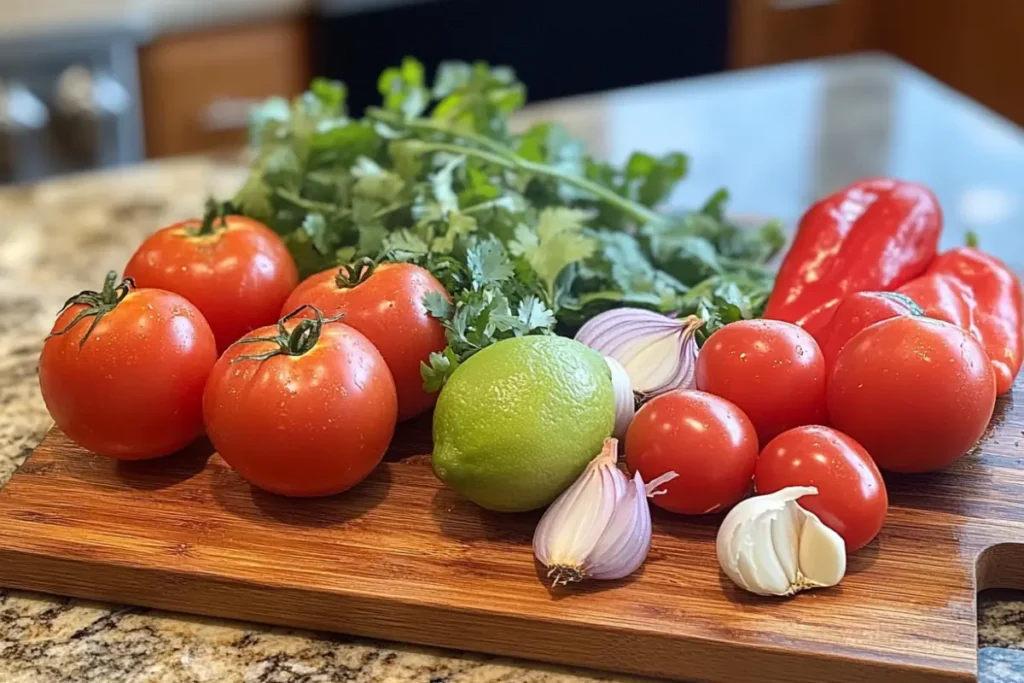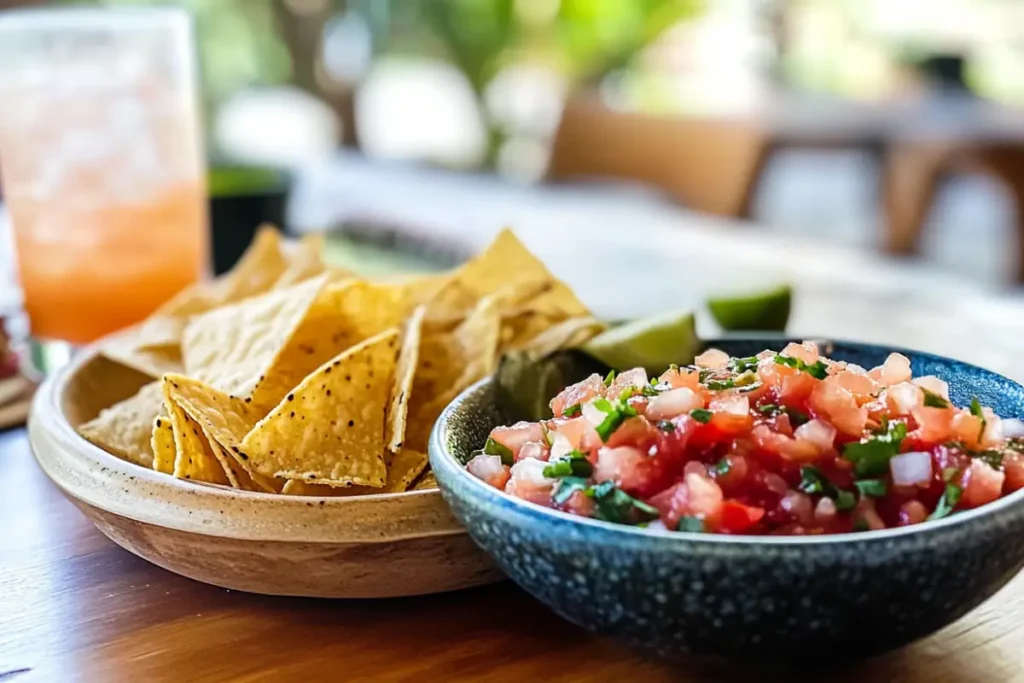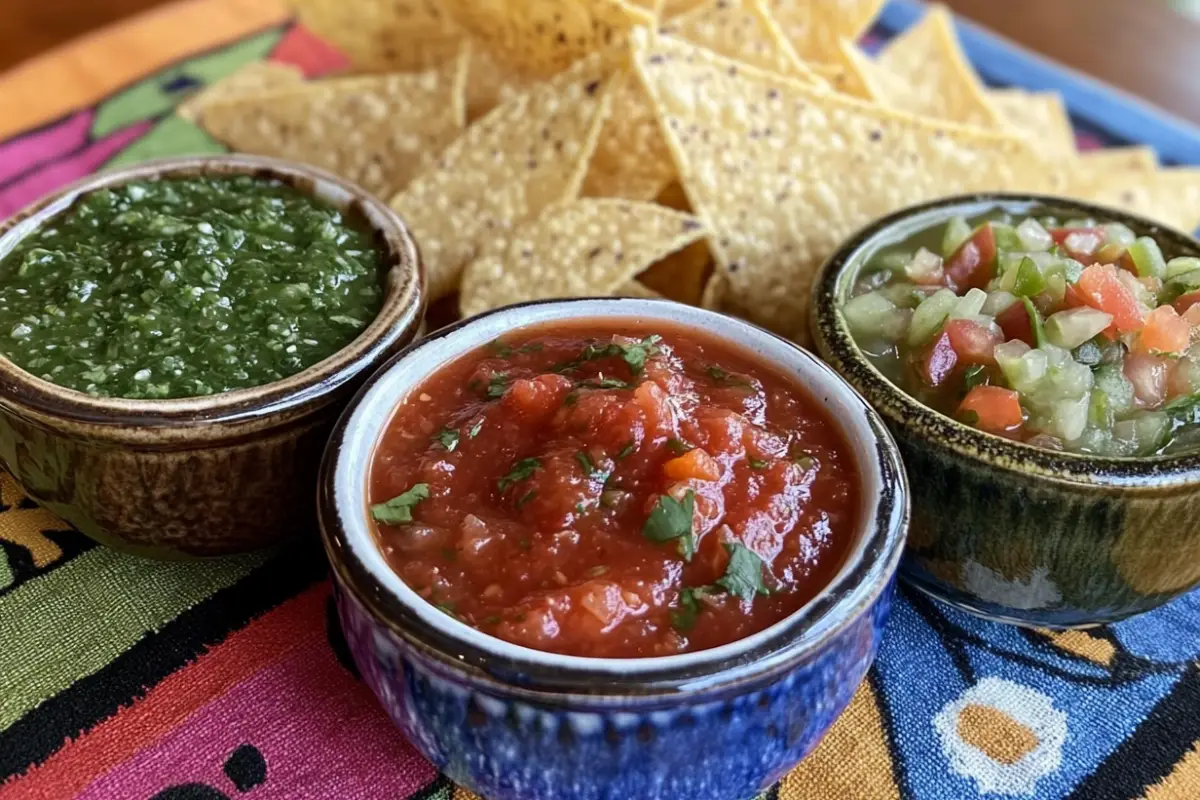Last Updated on February 12, 2025 by Souhail
Mexican restaurant salsa has an almost magical quality that keeps us coming back for more. It’s vibrant, fresh, and bursting with flavors that dance on your palate. But what makes it so irresistible? Let’s dive deep into the secrets behind why Mexican restaurant salsa tastes so good and explore how you can replicate it at home.
Table of contents
- The Freshest Ingredients Make All the Difference
- Balancing Flavor Profiles with Precision
- Traditional Preparation Techniques
- The Secret Ingredient: Time
- Regional Variations Bring Depth
- The Role of Fresh Tortilla Chips
- Love and Tradition in Every Bite
- Pro Tips for Making Restaurant-Style Salsa at Home
- Variants of Mexican Restaurant Salsa
- FAQs: Exploring the Magic of Mexican Restaurant Salsa
- Final Thoughts: Why Mexican Restaurant Salsa Is Irresistible
The Freshest Ingredients Make All the Difference

Mexican restaurants often use the freshest, high-quality ingredients, and it shows. The key components of salsa—ripe tomatoes, crisp onions, spicy peppers, fragrant cilantro, lime juice, and a touch of salt—are carefully selected to create a perfect balance of flavors.
- Ripe Tomatoes: The base of most salsas, especially the red varieties, relies on tomatoes picked at their peak ripeness. The natural sweetness and acidity of fresh tomatoes elevate the overall flavor.
- Fresh Cilantro: Love it or hate it, cilantro undeniably brings a unique citrusy, slightly peppery flavor that defines authentic salsa. Additionally, restaurants prioritize using cilantro that is exceptionally fresh, crisp, and aromatic, which truly makes all the difference in elevating the overall flavor profile of the dish.
- Lime Juice: This essential ingredient not only brightens up the salsa but also adds a tangy zest that beautifully complements the natural sweetness of the tomatoes and the warmth of the peppers. Additionally, it helps to create a harmonious balance of flavors, making the salsa irresistibly vibrant.
- Roasted Ingredients (Optional): Many restaurants roast or char their tomatoes, peppers, and onions, which adds a smoky depth of flavor that’s hard to achieve with raw ingredients alone.
Pro Tip: The quality of ingredients can make or break your salsa. Always opt for fresh, ripe, and aromatic produce for the best results.
Balancing Flavor Profiles with Precision
Mexican restaurants masterfully balance the five flavor profiles: sweet, sour, salty, bitter, and umami. Salsa is not just about heat—it’s about harmony.
- Heat with Nuance: Spicy peppers like jalapeños, serranos, or habaneros are used judiciously. The goal isn’t to overwhelm but to create a warmth that enhances the other flavors.
- Salt as a Flavor Enhancer: A pinch of salt amplifies the sweetness of the tomatoes and the zestiness of lime. Restaurants often taste-test to ensure the salt level is just right.
- Touch of Sweetness: Sometimes, a dash of sugar is added to balance out overly acidic tomatoes or lime.
The skillful balance of these elements ensures every bite is satisfying and flavorful.
Traditional Preparation Techniques
Mexican salsas aren’t just thrown together—they’re crafted with traditional methods that enhance their flavor.
- Molcajete Magic: Some restaurants still use a molcajete (a traditional Mexican mortar and pestle) to grind ingredients. This method releases natural oils from the ingredients, intensifying their flavors.
- Roasting and Charring: Roasting ingredients over an open flame or in the oven caramelizes their natural sugars, adding a smoky, complex flavor.
- Blending Techniques: Some salsas are blended until smooth, while others are left chunky for texture. The method of blending impacts how the flavors come together.
Pro Tip: Try using a molcajete or roast your ingredients at home for a truly authentic flavor.
The Secret Ingredient: Time
Salsa often tastes better after it has had time to sit. Letting the ingredients meld together allows the flavors to deepen and harmonize. Restaurants often prepare salsa hours or even a day before serving to maximize flavor.
Why Time Matters:
- Freshly made salsa has sharp, individual flavors.
- After resting, the acids in the lime juice and tomatoes break down tougher ingredients like onions and garlic, mellowing them and creating a cohesive taste.
Regional Variations Bring Depth
Mexican cuisine is incredibly diverse, and salsas reflect this regional richness. Restaurants may draw inspiration from different parts of Mexico, resulting in salsas with distinct flavors and textures.
- Salsa Roja: The classic red salsa, often made with tomatoes, peppers, and cilantro.
- Salsa Verde: A tangy green salsa made with tomatillos.
- Pico de Gallo: A chunky, fresh salsa that’s heavy on diced tomatoes and onions.
- Salsa de Árbol: A fiery, smoky salsa made with dried árbol chiles.
Each region’s twist on salsa adds to the delicious complexity you taste at your favorite Mexican restaurant.
The Role of Fresh Tortilla Chips
While salsa gets all the glory, let’s not forget the crucial role of fresh tortilla chips. Restaurants often serve salsa with chips that are made in-house—freshly fried, warm, and perfectly salted. These chips elevate the experience and complement the salsa beautifully.
Pro Tip: To replicate this at home, fry your own tortilla chips or buy high-quality ones for the best pairing.
Love and Tradition in Every Bite
Finally, the most important ingredient is passion. Mexican chefs take immense pride in their culinary heritage, and that love is evident in the salsas they prepare. Recipes are often handed down through generations, carrying with them the stories and traditions of Mexican culture.
Pro Tips for Making Restaurant-Style Salsa at Home
If you’re determined to replicate the irresistible taste of Mexican restaurant salsa at home, these tips will take your salsa game to the next level.
1. Use the Right Tomatoes
The quality of your tomatoes will make or break your salsa. For the best flavor:
- Use Roma tomatoes or vine-ripened tomatoes, as they have a perfect balance of sweetness and acidity.
- If fresh tomatoes aren’t in season, opt for high-quality canned San Marzano tomatoes, which are packed with flavor.
2. Roast or Char Your Ingredients
Roasting tomatoes, peppers, onions, and even garlic creates a smoky, caramelized flavor that mimics authentic restaurant salsas.
- How to Roast: Place your ingredients under the broiler or directly on a hot grill until they’re blistered and slightly charred.
- Pro Tip: Don’t over-roast; you want a smoky flavor, not burnt bitterness.
3. Master the Balance of Heat
Experiment with different chili peppers to find your perfect spice level:
- For mild heat, use jalapeños or poblano peppers.
- For medium heat, try serrano peppers.
- For a fiery kick, add a small amount of habanero or chile de árbol.
Always taste and adjust, as peppers vary in spiciness.
4. Blend to Your Desired Texture
Mexican restaurants often serve salsas in various textures, from chunky pico de gallo to smooth salsa roja. The secret is in the blending:
- For a chunky salsa, pulse the ingredients gently.
- For a smoother salsa, blend until silky, and strain if needed.
5. Add a Touch of Acid
A squeeze of fresh lime juice brightens up the flavors and balances the heat. If you want an extra zing, a splash of apple cider vinegar can work wonders.
6. Let It Rest
After preparing your salsa, let it sit for at least 30 minutes (or longer) before serving. This resting time allows the flavors to meld together, making the salsa taste richer and more cohesive.
7. Season Gradually
Salt is the unsung hero of salsa. Add it in small amounts, tasting as you go, to avoid overpowering the other flavors.
8. Experiment with Add-Ins
While traditional salsa ingredients are delicious on their own, some creative add-ins can elevate the flavor:
- A pinch of cumin for a smoky, earthy note.
- Diced avocado for a creamy twist.
- A splash of tequila for a fun, bold flavor.
Variants of Mexican Restaurant Salsa

Mexican restaurant salsas offer a variety of flavors, textures, and heat levels, making them suitable for every palate. Here’s a closer look at popular variations and how you can make a salt-free option at home without compromising on taste.
1. Salsa Roja (Classic Red Salsa)
This is the quintessential Mexican salsa served at most restaurants. Made with ripe tomatoes, onions, cilantro, and peppers, salsa roja effortlessly strikes the perfect balance of sweetness, acidity, and spice. Moreover, roasting the ingredients adds a smoky depth, further enhancing its flavor and setting it apart from the jarred salsas you’ll find in stores.
Pro Tip: To make a salt-free version, amplify the natural flavors of the ingredients by roasting them and using fresh lime juice to boost brightness.
2. Salsa Verde (Tangy Green Salsa)
A vibrant and tangy salsa made with tomatillos instead of tomatoes. Its tartness pairs beautifully with grilled meats or drizzled over enchiladas.
For a salt-free version, use a mix of fresh cilantro, lime juice, and cumin to bring out the flavors of the tomatillos.
3. Pico de Gallo (Chunky Fresh Salsa)
Pico de gallo is a raw, chunky salsa featuring diced tomatoes, onions, cilantro, and lime juice. Moreover, it’s incredibly versatile and works perfectly as a topping for tacos, burritos, or even as a refreshing dip served with crispy tortilla chips.
Salt-Free Twist: To further enhance the flavor without adding any salt, try including finely diced jalapeños for a subtle kick and a hint of garlic powder to add depth. Additionally, for an extra burst of brightness, consider doubling up on the lime juice to truly elevate the dish.
4. Salsa de Árbol (Fiery Chili Salsa)
This salsa brings the heat! Made with dried árbol chilies, it’s bold, smoky, and perfect for spice lovers. Blend with roasted garlic and tomatoes for a complex, rich flavor.
To skip the salt, add depth with a touch of smoked paprika and roasted cumin.
5. Mango or Pineapple Salsa (Sweet and Spicy)
A tropical variation that beautifully combines sweetness and heat, this salsa features fresh mango or pineapple paired with red onions, jalapeños, and cilantro. Furthermore, it’s an excellent complement to grilled fish or chicken, adding a vibrant and flavorful twist to your meal.
For a Salt-Free Version: To balance the natural sweetness of the fruit, incorporate fresh lime zest for a zesty kick and a pinch of chili powder for a subtle layer of heat. Additionally, these ingredients ensure the salsa remains flavorful and satisfying without relying on salt.
6. Salt-Free Salsa with Homemade Seasoning
For those seeking a low-sodium or no-salt option, this recipe relies on a custom seasoning blend to deliver bold flavors without the need for salt.
Looking to enjoy the bold, vibrant flavors of salsa without the added salt? Our Salt-Free Salsa Seasoning Recipe is the perfect way to create a heart-healthy, flavor-packed dip or topping that’s just as satisfying as its salty counterpart. With a balanced blend of spices like smoked paprika, cumin, and chili powder, this seasoning will elevate any salsa while keeping it guilt-free.
FAQs: Exploring the Magic of Mexican Restaurant Salsa
Restaurant salsa is fresher, often made daily, with high-quality ingredients and traditional preparation techniques like roasting or grinding in a molcajete. Store-bought salsa is often pasteurized for shelf life, which can mute its flavors.
The secret lies in the balance of fresh ingredients, traditional techniques, and the careful adjustment of flavors like heat, salt, and acidity.
Absolutely! Use fresh, ripe ingredients, roast or char them for depth, and let your salsa rest before serving to achieve restaurant-quality results.
Yes, most restaurant salsas are free from preservatives and rely on natural, fresh ingredients, making them a healthier choice.
Allowing salsa to rest gives the flavors time to meld and mellow, creating a more balanced and cohesive taste.
They often use high-powered blenders or strain their salsa for a silky texture, especially in smooth varieties like salsa roja.
Final Thoughts: Why Mexican Restaurant Salsa Is Irresistible
Mexican restaurant salsa captures the heart and soul of authentic Mexican cuisine. It’s a celebration of fresh ingredients, traditional techniques, and perfectly balanced flavors. Whether you’re dipping warm tortilla chips or spooning it onto tacos, it’s an experience that’s hard to replicate—but not impossible.
With the right ingredients, techniques, and a little love, you can effortlessly bring the magic of restaurant salsa into your own kitchen. Furthermore, by taking the time to experiment with different flavors and methods, you’ll soon discover the true joy of creating your own irresistible salsa masterpiece!

